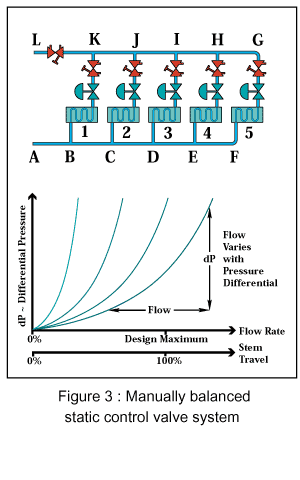| System Comparison-Valve Authority |
Consider the static control valve system shown below at a point of operation where all valves are throttling to provide 50% load. If the load requirement of coils 4 & 5 increased to 90%, valves 4 & 5 would open to increase flow rate. This would cause an increase in total flow and therefore pressure loss in pipework ABCD & IJKL which is common with coils 1 to 3. The pressure differentials across coils 1 to 3 would decrease causing an unwanted decrease in flow rate. Eventually, after room temperatures had been upset, the thermostats would re-adjust valves 1 to 3 . This would however interfere with the flow rate to coils 4 & 5.....
Now consider a system with 40 parallel static control valves. As each control valve adjusts, it interferes with the pressure differentials and flow rates to the other 39 valves and coils. Varing load requirements create a shifting target. Inevitable valve over or under sizing magnifies the problem. The addition of manual balancing valves robs authority from the control valves and only attempt to balance the system at the full flow condition which rarely occurs in a variable flow system.
The FlowCon SM 100% authority pressure independent flow control valves instantaneoulsy self-balance at all points of operation, even when there are extreme variances in pressure differentials that variable speed pump regulation cannot overcome. As long as the pressure differential across the valve is within the operating range, the Cv (Kv) of the valve is variable, being continuously regulated to keep the control valve in constant authority. |
  |
|
|
|